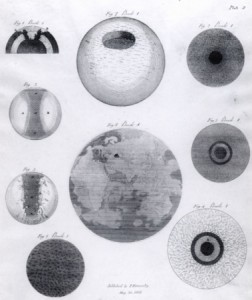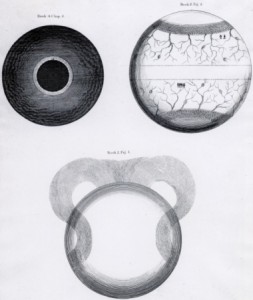Scientific Imagination Run Wild, Part 1
By Nir Menussi: February 4, 2011: Category Inspirations, Networks of Meaning
Integrating Science and Mysticism, Article 4
 In the previous article, we began to analyze the deep-rooted crisis of what we called the culture of the enlightenment – the modern belief that rationality, science and technology herald the coming of a secular salvation for mankind. We conducted our analysis by dividing the scientific enterprise into three categories—Theory, Imagination and Practice—and then subdividing them again according to the same three categories, resulting in a 3 by 3 ‘map’ of science’s main zones of activity. We surveyed 6 of the 9 zones, those dealing with the Practical and Theoretical dimensions of science. We now proceed to analyze the remaining three, which form the Imagination dimension of science.
In the previous article, we began to analyze the deep-rooted crisis of what we called the culture of the enlightenment – the modern belief that rationality, science and technology herald the coming of a secular salvation for mankind. We conducted our analysis by dividing the scientific enterprise into three categories—Theory, Imagination and Practice—and then subdividing them again according to the same three categories, resulting in a 3 by 3 ‘map’ of science’s main zones of activity. We surveyed 6 of the 9 zones, those dealing with the Practical and Theoretical dimensions of science. We now proceed to analyze the remaining three, which form the Imagination dimension of science.
The Scientific Imagination
For a certain period of time, science presented itself, and was believed by many to be, a purely rational activity, which derived clear-cut, inevitable conclusions from observation and reasoning. Although it’s definitely true that scientific method in the strict sense abides to rigorous rules and is far from capricious, most intelligent people today realize that science as a whole—the modern-day telling of the world story—does not develop in a sterile, computer program-like environment, but like any other human activity is subject to various influences. It is influenced by the culture in which it takes place, by the beliefs, hopes and fears held by its surrounding society, and even by the scientist’s own personality and inclinations. Not only that, but science also affects the people under its influence, by forging their mental picture of the world.
This element of science—its give-and-take interaction with society, culture and psychology—is what we call the scientific imagination. The reason for this term is that the main non-scientific element which flows in and out of science is images. It is the images acquired from his culture that jostle in the young scientist’s mind and inspire him to come up with a new image of the world; it is an image of the world that trickles down from science to the layman and forms part of his culture. In addition, it is this level of imagery which serves as intermediary between the two other main levels of science, theory and practice: the practical implementation of scientific knowledge is hugely dependent upon the image we have in our heads of what would be a useful thing to do with new knowledge.
Where does the crisis of modernity exhibit itself in the scientific imagination?
The Influence of Scientific Imagination (Practice within Imagination)
 We’ll start at the bottom, with science’s influence on society. While science has certainly enriched and widened our picture of the world, it has also robbed it of its soul. We used to inhabit a creation, a living and breathing animal of a world, which by definition motions towards a creator, which is forever endowed with meaning, and in which our existence has a purpose that we can seek and fulfill. But we have been plucked from this world and plunged into a universe, a hollow machine of a world, blindly ticking away its astronomical lifetime in an orderly but purposeless fashion. It is not even a cosmos like the Greeks (among others) had, which, while also without lacking a personal creator, at least has some rhyme and reason to it. In the ‘universe’ there is no rhyme or reason, only random shapes which temporarily arise from the primordial mud, dream fleeting dreams of meaning, and quickly collapse back into the mud. To quote a popular piece of fiction, in such a universe human beings are no more than “animals with brains who talk us into thinking we’re not.”
We’ll start at the bottom, with science’s influence on society. While science has certainly enriched and widened our picture of the world, it has also robbed it of its soul. We used to inhabit a creation, a living and breathing animal of a world, which by definition motions towards a creator, which is forever endowed with meaning, and in which our existence has a purpose that we can seek and fulfill. But we have been plucked from this world and plunged into a universe, a hollow machine of a world, blindly ticking away its astronomical lifetime in an orderly but purposeless fashion. It is not even a cosmos like the Greeks (among others) had, which, while also without lacking a personal creator, at least has some rhyme and reason to it. In the ‘universe’ there is no rhyme or reason, only random shapes which temporarily arise from the primordial mud, dream fleeting dreams of meaning, and quickly collapse back into the mud. To quote a popular piece of fiction, in such a universe human beings are no more than “animals with brains who talk us into thinking we’re not.”
This picture of the world has long since become part of our mental landscape, so much so, that it functions like a backdrop or soundtrack to our lives, to which we hardly pay conscious attention, if at all. Defenders of this worldview tell us that it is an inescapable result of our scientific discoveries, and that to imagine otherwise is to hurtle us all back to the dark ages of the pre-scientific era. But make no mistake, it isn’t. At best, it is a dedicated exercise in forming a worldview involving only known material elements, with all other kinds of elements and processes barred out. But why should they be barred out? Matter certainly matters, but why in the universe should it be the only thing that matters? Especially when a far-more immediate (and empirical for that matter) subjective experience tells us there are also mind, and meaning – and a multidimensional method of interpreting them in ways far more ranging than those of science.
The space between the solid knowledge directly gained from scientific enquiry, and the picture of the world it ultimately gives us, is where imagination is injected. That such a heavy dosage of imagination was administered to us unnoticed by almost everyone, and that it has affected us so negatively, is a major component of the contemporary crisis of the scientific age.
Coming up Next: Scientific Imagination Run Wild, Part 2
Scientific Imagination Run Wild, Part 1 ,






















;)
;)
;)
;)
;)
;)
;)
;)
;)
;)
